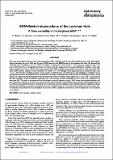Por favor, use este identificador para citar o enlazar a este item:
http://hdl.handle.net/10261/170247COMPARTIR / EXPORTAR:
 SHARE SHARE
 CORE
BASE CORE
BASE
|
|
| Visualizar otros formatos: MARC | Dublin Core | RDF | ORE | MODS | METS | DIDL | DATACITE | |

| Título: | XMM-newton observations of the Lockman Hole |
Otros títulos: | V. Time variability of the brightest AGN | Autor: | Mateos, Silvia CSIC ORCID ; Barcons, Xavier CSIC ORCID ; Carrera, Francisco J. CSIC ORCID CVN ; Ceballos, María Teresa CSIC ORCID ; Hasinger, Günther; Fabian, Andrew C. | Palabras clave: | Galaxies: active X-ray general |
Fecha de publicación: | 2007 | Editor: | EDP Sciences | Citación: | Astronomy and Astrophysics 473(1): 105-120 (2007) | Resumen: | This paper presents the results of a study of X-ray spectral and flux variability on time scales from months to years, of the 123 brightest objects (including 46 type-1 AGN and 28 type-2 AGN) detected with XMM-Newton in the Lockman Hole field. We detected flux variability with a significance ≥3σ in ∼50% of the objects, including 68 ±11% and 48 ±15% among our samples of type-1 and type-2 AGN. However we found that the fraction of sources with best quality light curves that exhibit flux variability on the time scales sampled by our data is ≥80%, i.e the great majority of the AGN population may actually vary in flux on long time scales. The mean relative intrinsic amplitude of flux variability was found to be -0.15 although with a large dispersion in measured values, from ∼0.1 to ∼0.65. The flux variability properties of our samples of AGN (fraction of variable objects and amplitude of variability) do not significantly depend on the redshift or X-ray luminosity of the objects and seem to be similar for the two AGN types. Using a broad band X-ray colour we found that the fraction of sources showing spectral variability with a significance ≥3σ is ∼40% i.e. less common than flux variability. Spectral variability was found to be more common in type-2 AGN than in type-1 AGN with a significance of more than 99%. This result is consistent with the fact that part of the soft emission in type-2 AGN comes from scattered radiation, and this component is expected to be much less variable than the hard component. The observed flux and spectral variability properties of our objects and especially the lack of correlation between flux and spectral variability in most of them cannot be explained as being produced by variability of one spectral component alone, for example changes in Γ associated with changes in the mass accretion rate, or variability in the amount of X-ray absorption. At least two spectral components must vary in order to explain the X-ray variability of our objects. | Versión del editor: | https://doi.org/10.1051/0004-6361:20077909 | URI: | http://hdl.handle.net/10261/170247 | DOI: | 10.1051/0004-6361:20077909 | Identificadores: | doi: 10.1051/0004-6361:20077909 issn: 0004-6361 e-issn: 1432-0746 |
| Aparece en las colecciones: | (IFCA) Artículos |
Ficheros en este ítem:
| Fichero | Descripción | Tamaño | Formato | |
|---|---|---|---|---|
| XMMVagn.pdf | 1,05 MB | Adobe PDF |  Visualizar/Abrir |
CORE Recommender
SCOPUSTM
Citations
20
checked on 13-abr-2024
WEB OF SCIENCETM
Citations
20
checked on 25-feb-2024
Page view(s)
256
checked on 19-abr-2024
Download(s)
196
checked on 19-abr-2024
Google ScholarTM
Check
Altmetric
Altmetric
NOTA: Los ítems de Digital.CSIC están protegidos por copyright, con todos los derechos reservados, a menos que se indique lo contrario.
